What Species Will Be Counted?
This is the hardest part of your job! You need to memorize the calls of the 6 targeted species listed below. Fortunately they are easy to learn.
The online sound files listed below are of high sound quality. Download the calls for the 6 target species here Download
There are many species of crickets and katydids that are not part of this count. In many cases most of the sounds
you are hearing at night come from these groups....these form the background of soft churrs and trills that emanate from a series of
different small ground and tree crickets (for a real challenge, try and locate these singers sometime....). Because many of these species can be difficult to separate from
one another we are not asking you to count them. However, we do provide links to them below as you may be interested in checking out and taking the time to learn more about these species, references and pictures are at Lang Elliott
and Wil Hershberger’s (WH) and
Tom Walker’s (TW) wonderful web sites.
Cricket
Targets
Photographs courtesy of Wil Hershberger
|
Jumping Bush Cricket
Orocharis saltator (EH,
TW)
-- This is an ubiquitous cricket that gives a periodic SINGLE PEEP call and lives throughout the
shrubbery surrounding suburban and city yards.
|
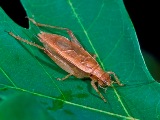
|
 Japanese Burrowing Cricket Velarifictorus micado (TW) - A Japanese native species, first discovered in the US in 1959. This cricket has a largely suburban distribution.
It's chirp is similar to the Fall Field Cricket but the Japanese species calls twice as fast.This species only sings from the ground. Snowy Tree Cricket may occur here but they will be singing from trees and shrubs.
Japanese Burrowing Cricket Velarifictorus micado (TW) - A Japanese native species, first discovered in the US in 1959. This cricket has a largely suburban distribution.
It's chirp is similar to the Fall Field Cricket but the Japanese species calls twice as fast.This species only sings from the ground. Snowy Tree Cricket may occur here but they will be singing from trees and shrubs.
|
Note that if you have significant hearing loss you are unlikely to hear some of the species below
Katydid Targets
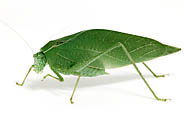
|
Greater Anglewing Microcentrum rhombifolium
(EH,
TW)
– A leaf-like katydid that lives at the very top of shade trees.
It gives a distinct set of tics that increases greatly in speed toward the end…LIKE A RAPIDLY BOUNDING BALL.
|
|
Lesser Anglewing Microcentrum retinerve
(EH,
TW) – Another
tree-top species, usually common in urban areas,
this species has a DISTINCT PATTERN OF 2-3 SHUSHS WITH LONG PAUSES INBETWEEN. Can be confused with the Common True, which calls continuously without pauses.
|
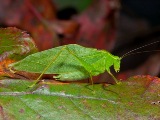
|
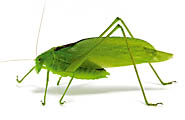
| Oblong-winged Katydid Amblycorypha oblongifolia
(EH,
TW) – A species of the understory, low shrubs, and lower layers of the forest, it will be interesting to see this
species pattern in the city.
This species has a unique TWO-PART CALL -ZZZZZ-TIC - GIVEN EVERY FEW SECONDS
|
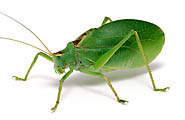
|
Common True Katydid Pterophylla camellifolia
(EH,
TW)
-- This is a katydid of the forest. An easy one to identify because it calls non-stop giving
CONTINUOUS SERIES OF SHUSHES often in groups of 2's and 3's.
|
|


 Japanese Burrowing Cricket Velarifictorus micado (TW) - A Japanese native species, first discovered in the US in 1959. This cricket has a largely suburban distribution.
It's chirp is similar to the Fall Field Cricket but the Japanese species calls twice as fast.This species only sings from the ground. Snowy Tree Cricket may occur here but they will be singing from trees and shrubs.
Japanese Burrowing Cricket Velarifictorus micado (TW) - A Japanese native species, first discovered in the US in 1959. This cricket has a largely suburban distribution.
It's chirp is similar to the Fall Field Cricket but the Japanese species calls twice as fast.This species only sings from the ground. Snowy Tree Cricket may occur here but they will be singing from trees and shrubs.



